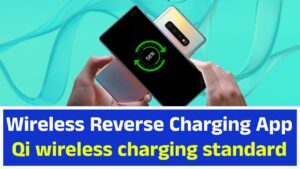Wireless Charging App
What Is Wireless Reverse Charging?
Wireless Reverse Charging (also known as Wireless PowerShare or Battery Share) allows a smartphone to act as a wireless power source and charge other devices like

- Phones
- Smartwatches
- Earbuds
- Styluses
- Bluetooth accessories
How It Works
- Uses Qi wireless charging standard (based on electromagnetic induction).
- The phone’s charging coil emits power instead of receiving it.
- Devices are placed back-to-back for charging.
- Requires hardware support and manual activation in phone settings.
Supported Devices
Smartphones:
- Samsung: Galaxy S10 and later (PowerShare)
- Huawei: Mate 20 Pro, P30 Pro, Mate 40
- Google Pixel 5+
- Xiaomi: Mi 10, 12, 13 series
- OnePlus: 11, 12 Pro
- iPhone: Reverse charging expected soon (via MagSafe)
Accessories:
- Galaxy Buds / Watch
- Pixel Buds
- AirPods Pro (limited support)
- Huawei smartwatches
- TWS earbuds and wearables
Enabling Reverse Charging
System Settings:
- Samsung: Settings > Battery > Wireless PowerShare
- Huawei: Settings > Battery > Reverse Charging
- Pixel: Settings > Battery > Battery Share
No app can enable reverse charging — only monitor, log, or assist it.
Best Apps for Monitoring
| App | Features |
|---|---|
| Ampere | Measures current, voltage, battery health |
| AccuBattery | Tracks wear, charge cycles, temp |
| Battery Guru | Alerts for overheating, usage patterns |
| Battery Log | Logs sessions for analysis |
Note: Apps don’t enable reverse charging. They analyze performance and safety.
Use Cases
- Charging wearables and earbuds on-the-go
- Sharing battery in emergencies
- Powering low-power gadgets when no plug is available
Benefits
- Ultra-convenient for small gadgets
- Reduces dependency on cables
- Great for travel, emergencies, or minimalism
- Helps in keeping devices powered on the move
Limitations
- Slow charging (4.5W–10W max)
- Not all devices compatible
- Drains phone battery quickly
- Needs proper alignment and positioning
- Overheating risks with prolonged use
Impact on Battery
- Mild use: Minimal effect
- Frequent use: Can increase battery wear and heat
- Use apps like AccuBattery to monitor long-term effects
Myths vs Facts
| Myth | Fact |
|---|---|
| It charges just as fast as wired charging | Wireless is much slower |
| All phones support it | Only select models with reverse coils |
| It works from a distance | Requires close, physical contact |
| Unsafe for your battery | Safe with limited use and monitoring |
Safety Tips
- Remove metal phone cases
- Avoid using while charging
- Don’t charge devices overnight via reverse
- Use apps to track heat & power flow
Wired vs Wireless Reverse Charging
| Feature | Wired | Wireless |
|---|---|---|
| Speed | Fast (10–20W) | Slow (4.5–10W) |
| Convenience | Less | High |
| Port Needed | Yes (USB OTG) | No |
| Surface Contact | No | Yes |
| Cable Required | Yes | No |
Future Trends
- Support for multiple devices at once
- Faster speeds (15W+ reverse charging)
- Smart control apps with better monitoring
- Apple iPhones expected to get official reverse charging
- Integration with laptops, power banks, EVs
Tips for Better Usage
- Keep phones cool while reverse charging
- Use only for short bursts or emergencies
- Avoid thick cases or magnets between devices
- Place devices aligned for better efficiency
- Monitor with apps like Battery Guru and AccuBattery
Final Takeaway
Wireless Reverse Charging is a smart feature that turns your phone into a mini wireless charger, perfect for topping up gadgets in everyday situations. While it’s not a fast-charging method, it provides tremendous convenience in a world full of wireless devices. Use it wisely, track performance using helpful battery apps, and stay safe with mindful practices.
